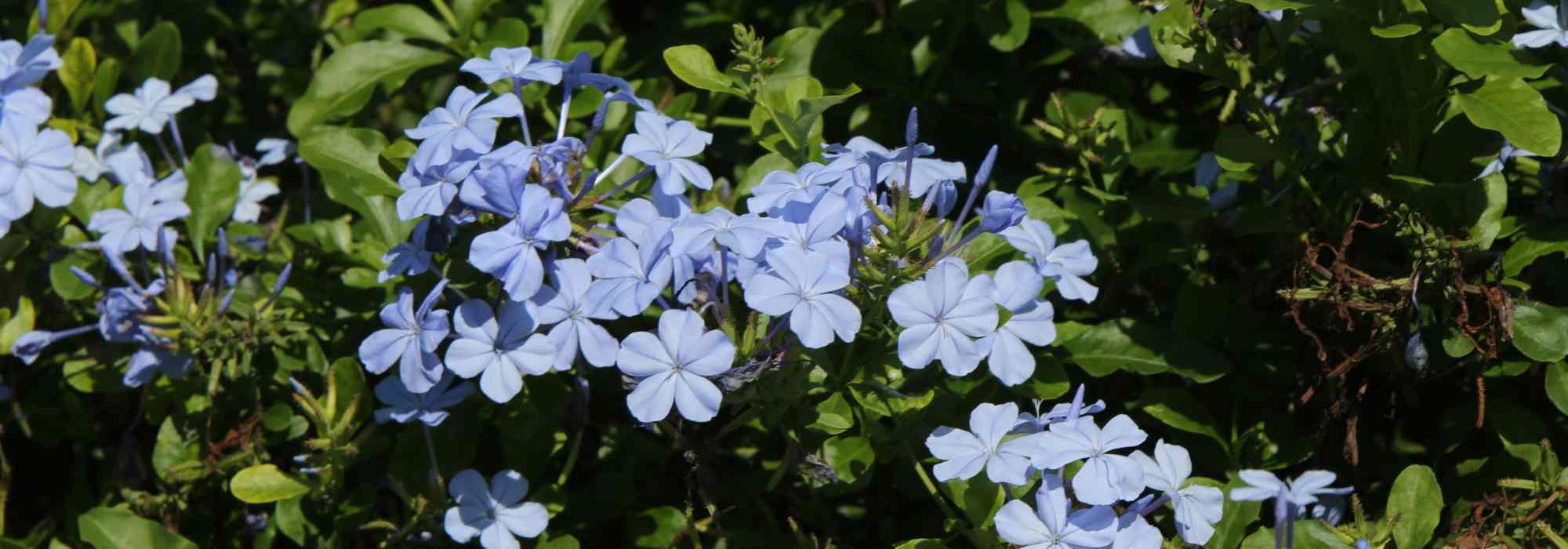
Cape Leadwort - Plumbago : growing and care
Contents
Cape leadwort in a few words
- The Cape Leadwort is known for its stunning azure blue flowers clustered together, blooming abundantly from spring to autumn.
- It is a fast-growing climbing plant that can reach up to 2 metres in height, perfect for covering trellises, walls, or pergolas.
- It is low-maintenance and thrives in well-drained soil, with moderate watering and occasional pruning.
- Native to South Africa, hence its name, the Cape Leadwort has limited frost resistance (-6°C) and requires winter protection in colder regions.
- There are several varieties of Cape Leadwort, some of which offer white flowers or deeper blue blooms.
The word from our expert
In the vast horticultural universe, certain plants captivate with their beauty and ease of cultivation, becoming must-haves for garden enthusiasts. The Plumbago auriculata, commonly known as Cape Leadwort, is one such rare gem that adorns gardens with its celestial blue hues. Native to South Africa, this robust and graceful plant has adapted to various environments, charming gardeners around the globe. With its generous and prolonged flowering, the Plumbago offers a remarkable visual spectacle, while its ease of cultivation makes it a preferred choice for gardens in areas where winters are not too harsh.
Beyond its undeniable aesthetic appeal, the Cape Leadwort stands out for its resilience and versatility, adapting to a variety of climatic conditions and soils. Whether in flower beds, pots, or as ground cover, it knows how to enhance every corner of the garden. Moreover, its ability to attract pollinators makes it a valuable ally for biodiversity.
Our article invites you to delve into the world of this astonishing climbing plant, exploring its history, botanical characteristics, cultivation needs, and multiple garden uses. Join us on this botanical journey to discover how to integrate this splendid plant into your garden.

Plumbago auriculata
Botany and description
Botanical data
- Latin name Plumbago auriculata
- Family Plumbaginaceae
- Common name Cape leadwort - Cape plumbago
- Flowering July to October
- Height 1.50 m
- Exposure sun, partial shade
- Soil type rich, moist, well-drained soil
- Hardiness -6°C
The botanical genus Plumbago belongs to the Plumbaginaceae family, a group of plants known for their members adapted to a variety of habitats, often in saline or calcareous environments. The genus name “Plumbago” is derived from the Latin word for lead (“plumbum”), due to an ancient belief that these plants could cure lead poisoning or wounds caused by lead projectiles. The genus includes around twenty species, among which:
- Plumbago auriculata (formerly Plumbago capensis): Cape leadwort or Cape plumbago
- Plumbago europaea: European leadwort
- Plumbago indica: Red leadwort or Indian leadwort
- Plumbago zeylanica: Ceylon leadwort
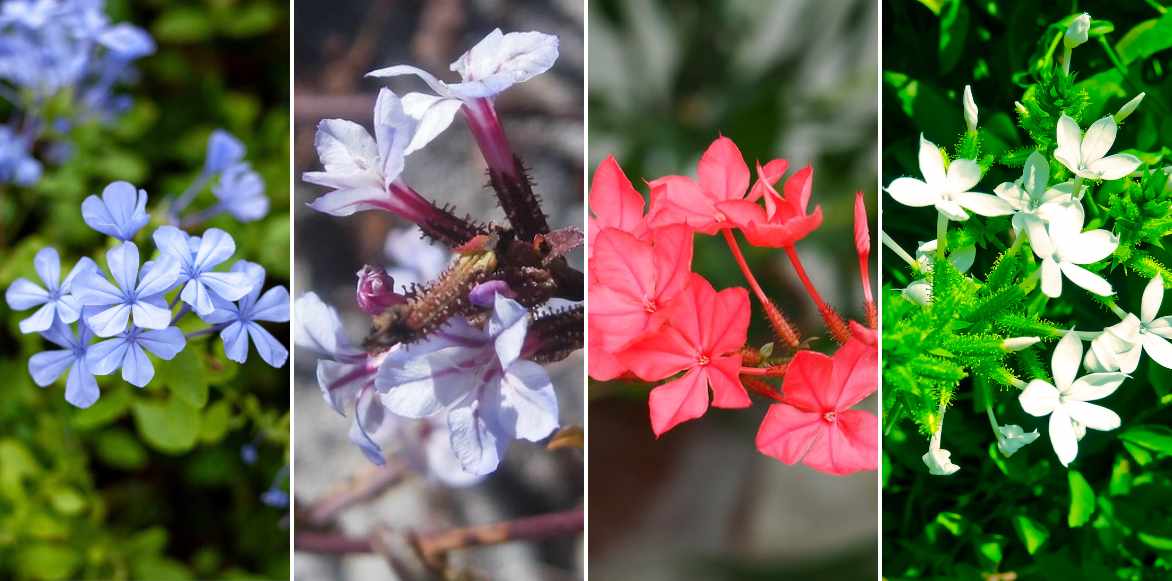
Plumbago auriculata, Plumbago europaea, Plumbago indica (© Teresa Grau Ros) and Plumbago zeylanica.
The Plumbago auriculata, often referred to as Cape leadwort, is undoubtedly the most widespread and cultivated species within the genus. Characterised by bright blue flowers, sometimes pale blue or white, this climbing or shrubby plant is native to South Africa. It is prized for its abundant and prolonged flowering, which can last from summer to autumn, or even year-round in warmer climates.
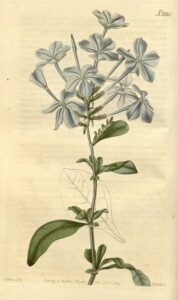
Plumbago capensis, botanical illustration.
Cape leadwort exhibits a semi-erect to creeping habit, making it extremely versatile in the garden. This plant can reach a height of 1 to 2 metres and spread to a similar width, offering a bushy and spreading growth. Thanks to its long and flexible stems, Plumbago auriculata can easily be trained to climb supports or trellises, making it an excellent choice for pergolas, walls, or fences. However, Plumbago auriculata is also used as ground cover in large areas where its dense foliage can quickly cover the soil, preventing weed growth and contributing to soil erosion control.
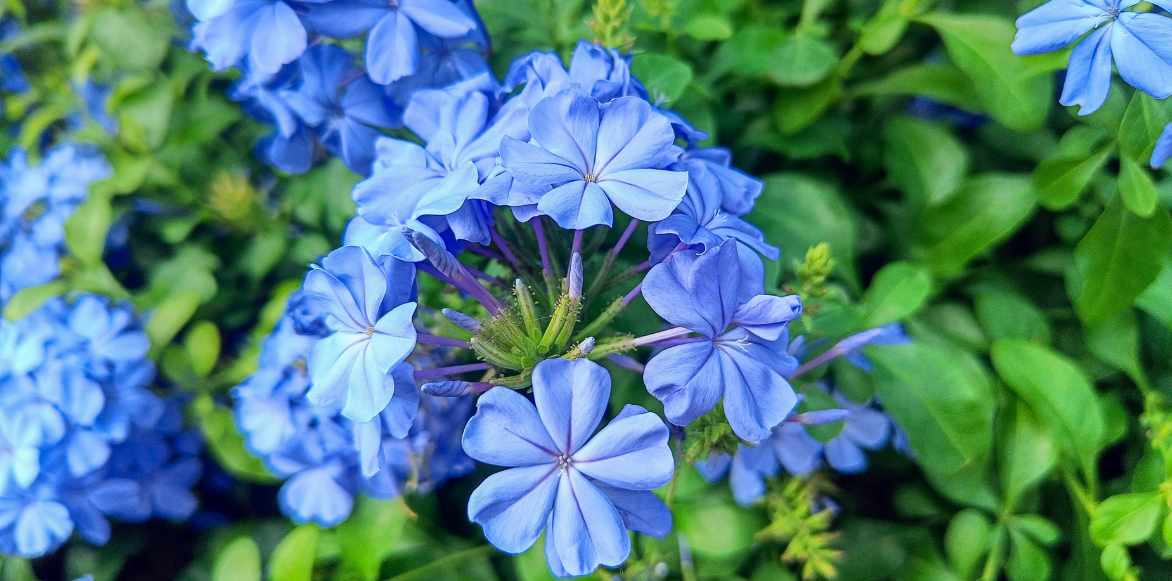
The evergreen leaves of Plumbago auriculata are green, oblong to ovate, measuring about 5 cm in length. They provide a dense and lush backdrop, against which the sky-blue to pale blue flowers (sometimes white depending on the variety, e.g., Plumbago auriculata ‘Alba’) stand out particularly well. These flowers, grouped in terminal inflorescences shaped like cymes, bloom abundantly from summer to autumn, and in warm climates, they may even continue to flower throughout the year. Each flower is tubular, opening into five spreading lobes that form an almost flat corolla. This shape is adapted to attract and facilitate access for pollinators such as butterflies. The flowers measure about 2 to 3 cm in diameter.
The flowers are grouped in terminal inflorescences, forming feathery cymes. These clusters can be quite dense, with each inflorescence bearing numerous flowers that together create a spectacular visual effect. The inflorescences can measure up to 15 cm in length, contributing to the bushy and spreading appearance of the plant. At the centre of each flower, five prominent stamens encircle the style, adding to the decorative appeal of the flower. Plumbago auriculata is adapted for cross-pollination, with pollinators playing a key role in the fertilisation process.
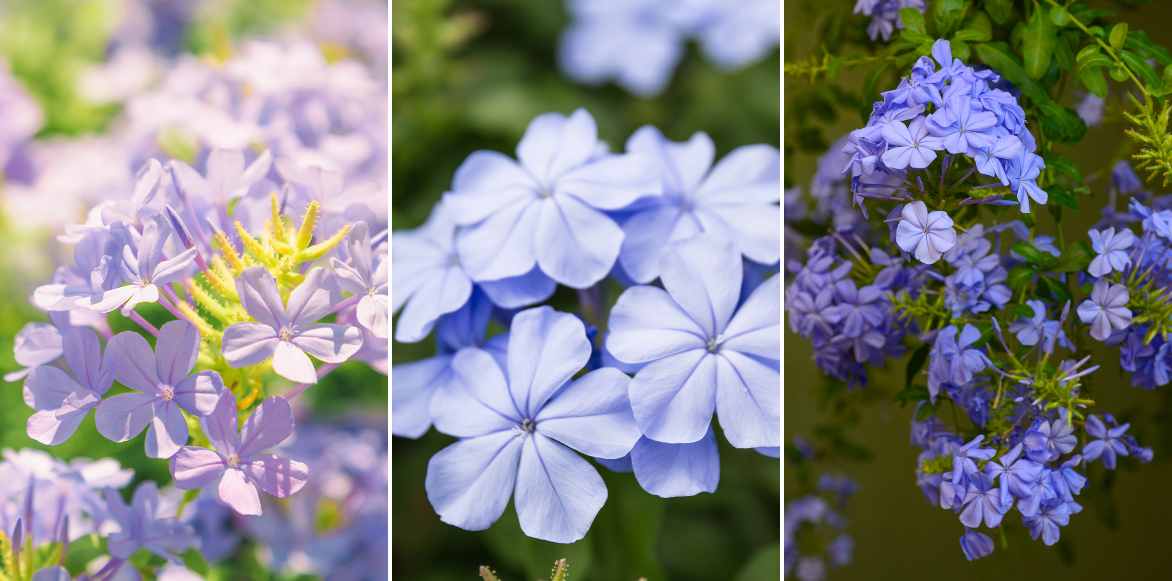
Flowers with varying shades of blue depending on exposure and time of day
After pollination, the plant produces a small fruit, which is a capsule containing the seeds. However, in gardens, the focus is primarily on the flowering rather than the fruiting.
The best varieties
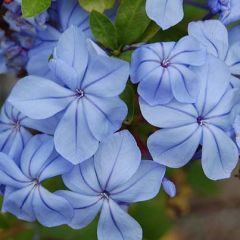
Plumbago auriculata
- Blütezeit August to November
- Höhe bei Reife 1,50 m

Plumbago auriculata Dark Blue
- Blütezeit August to November
- Höhe bei Reife 1,50 m
How to plant a Cape Plumbago?
When to Plant?
The ideal time to plant Plumbago auriculata is in spring, after the last frosts, or in autumn in regions with a mild climate. This allows the plant to establish itself and acclimatise before periods of extreme heat or cold.
Where to Plant?
Cape Leadwort thrives in full sun or partial shade. Choose a location that receives at least 6 hours of direct sunlight per day to encourage abundant flowering. The plant also prefers a neutral to slightly acidic, well-drained, fertile soil rich in organic matter.
The hardiness of Plumbago auriculata can be classified in USDA zones 9-11, meaning it can tolerate minimum temperatures down to -6.7°C (-9°C theoretically for the ‘Dark Blue’ variety). In these zones, Plumbago auriculata can be grown in the ground as an evergreen perennial, enjoying almost continuous flowering throughout the year in warmer climates. In regions where winter temperatures regularly drop below -6.7°C, it is advisable to grow Plumbago auriculata in pots or containers so it can be moved to a sheltered space during the coldest months. This method protects it from frost and ensures a safe dormancy period for its root system.
How to Plant a Plumbago?
- Before planting, loosen the soil to a depth of 30 to 40 cm and add compost to improve the soil.
- Dig a planting hole twice as wide as the plant’s pot.
- Gently remove the Plumbago from its pot, place it in the hole, and adjust the height so the base of the plant is level with the ground.
- Fill the hole with the excavated soil, lightly firm it down, and water thoroughly to avoid any “air pockets” between the roots and the soil.
Important! To protect a Plumbago from the cold, ensure it has well-drained soil, a good mulch at the base, a location near a south-facing wall, and, if necessary, protect the plant with winter fleece.
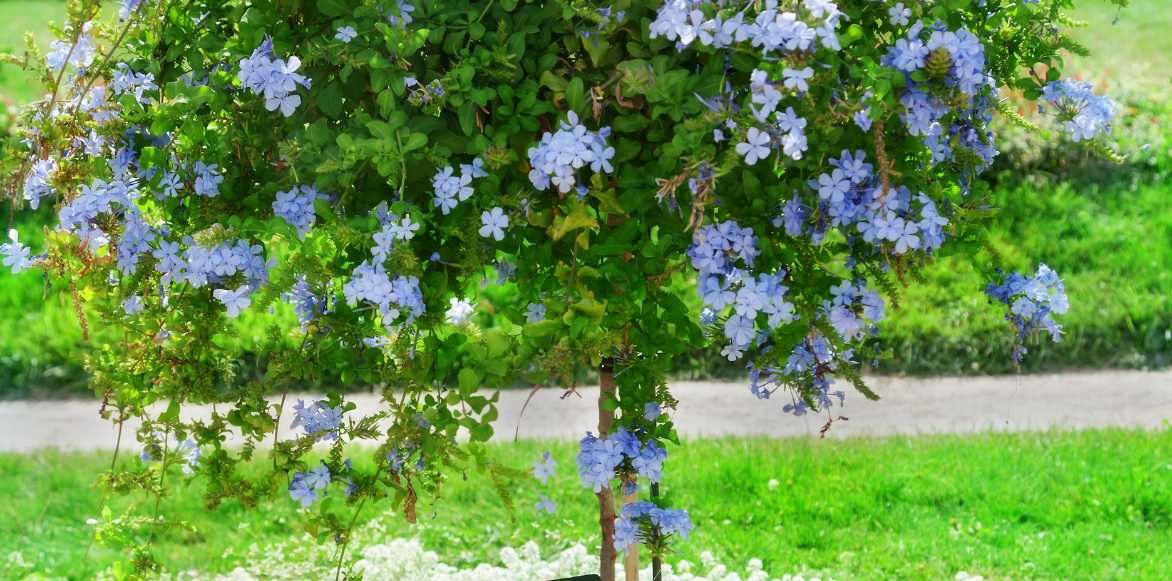
A Plumbago trained here on a stem
Maintenance of Cape Leadwort
After planting, water the Plumbago auriculata regularly, especially during dry spells, to keep the soil slightly moist. Mulching can help retain soil moisture, reduce weed growth, and protect the roots during winter.
Prune the plant lightly after flowering to encourage new growth and a more abundant flowering the following year.
Multiplication
Propagation by Cuttings
Propagation by cuttings is one of the most effective methods to multiply Plumbago auriculata. Choose this technique between April and July, when the plant is in full growth.
- Select healthy and vigorous stems from the current year, without flowers, and cut sections about 15 cm long.
- Remove the leaves from the lower third of each cutting to prevent rot, reduce evapotranspiration, and stimulate root formation.
- You can dip the cut end in plant hormone to encourage rooting, but this step is optional.
- Plant the cuttings in a light and well-draining potting mix, such as special propagation compost.
- Keep the substrate moist but not waterlogged, and place the cuttings in a bright spot without direct sunlight.
- The roots should start developing within a few weeks, after which you can transplant them into individual pots before moving them to the garden.
Division
You can also attempt division on a well-established plant, ideally in spring or autumn.
- Carefully dig up the mother plant, taking care not to damage the roots.
- Gently separate the clump into several sections, each with a portion of roots and healthy shoots.
- Replant the divisions immediately in their new location in the garden or in pots, respecting the plant’s specific soil and light requirements.
- Water generously after planting to help the new plants establish themselves.
Pests and Diseases
The Plumbago auriculata, like other plumbago species, is generally hardy and not prone to pest attacks or diseases. However, certain conditions can encourage the appearance of specific problems.
Common Pests
- Aphids: These small sap-sucking insects can weaken the plant and encourage the spread of diseases. To combat them, a treatment based on insecticidal soap or neem oil is effective. Spray the solution on the affected areas, ensuring to reach the undersides of the leaves where aphids like to hide.
- Spider mites: These tiny mites prefer hot and dry conditions. They spin fine webs on plants and can cause yellowing of the leaves. Increasing humidity around the plant can deter them. In case of infestation, applying miticides or neem oil can help control the problem.
Possible Diseases
- Root rot: Caused by excess moisture around the roots, this condition can be fatal for plumbago. Ensure the soil is well-drained and avoid overwatering. If rot is detected, it may be necessary to remove the affected parts and replant in fresh, well-drained soil.
- Powdery mildew: This fungus forms a white powdery coating on the leaves and stems. It thrives in conditions of high humidity and moderate temperatures. To treat it, reduce humidity around the plant and apply a specific fungicidal treatment according to the manufacturer’s instructions.
Prevention is Key
Prevention is the best strategy to avoid pest and disease problems. Here are some tips:
- Ensure your plumbagos are planted in well-drained soil and in the right location, respecting their sunlight requirements.
- Maintain good air circulation between plants to reduce humidity and the likelihood of fungal infections.
- Regularly inspect your plants for any signs of trouble and act quickly to prevent spread.
How to best pair a Cape leadwort?
Pairing the Plumbago auriculata ‘Dark Blue’ with other plants that share its growing requirements is an excellent way to create harmonious compositions in the garden. Choose companions that thrive under the same sunlight conditions, from full sun to partial shade, and appreciate well-drained soil. The Lavandula x intermedia ‘Dutch Group’, with its blue-violet hues and aromatic foliage, offers a fascinating colour contrast with the deep blue of the Plumbago, while sharing a love for sun and well-drained soil, adding a Mediterranean touch to the garden. Still within Mediterranean plants, the rosemary ‘Corsican Blue’, with its semi-creeping habit, provides evergreen foliage and blue-mauve flowers that will complement the Plumbago beautifully.
We also appreciate the rosemary-leaved santolina, with its silvery foliage and yellow summer flowers, offering a contrasting play of colours and textures alongside the Plumbago, both enjoying dry conditions. Blue-flowered agapanthus adds a vertical dimension with their spectacular flowering, sharing similar needs in terms of sunlight exposure and soil quality, ideal for borders or mixed beds. Finally, the lamb’s ear-Stachys byzantina ‘Big Ears’ will create a contrast in colour and texture with its silvery, fuzzy foliage against the green and blue of the Plumbago. All these plants can be grown in pots for a soft, summery ambiance, perfect for a cosy corner to enjoy morning tea in the garden or on a balcony.
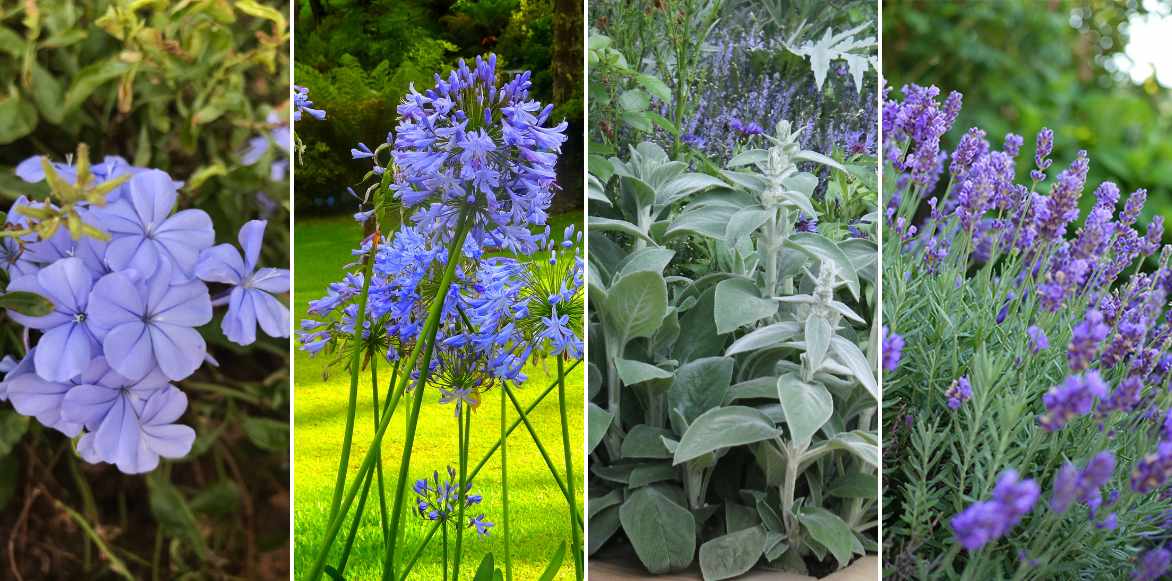
Plumbago auriculata, Agapanthus, Stachys byzantina ‘Big Ears’, and Lavandula x intermedia ‘Dutch Group’
Anecdotes
- A quirky name! : The genus name “Plumbago” comes from the Latin “plumbum”, meaning lead, due to the ancient belief that the plant could cure lead poisoning. This association with lead also led to its use in traditional remedies for bullet wounds in the Middle Ages, although no scientific evidence supports these medicinal uses.
- An uncertain love! : In the language of flowers, Plumbago symbolises both pure love and uncertain love. This duality likely stems from its ability to thrive with minimal care, representing unconditional love, while its flowers appear delicate and almost shy, evoking uncertainty.
- Quite tough! : A Plumbago auriculata reportedly survived and flowered after being forgotten in a dark garage for several months, showcasing its remarkable resilience.
- Butterfly restaurant: The Cape Leadwort is not only admired for its beautiful blue or white flowers, but it is also highly attractive to butterflies.
- The name “dentelaire” is attributed to the 18th day of the month of Brumaire in the French Republican or revolutionary calendar, generally corresponding to the 8th of November in the Gregorian calendar.
Also worth reading...
Find all Cape Leadworts and the ‘Dark Blue’ variety in our online nursery.
Other plants are sometimes called “plumbago” or “leadwort”, such as the plants of the botanical genus Ceratostigma. Discover them in our family guide on Ceratostigma.
If you’re a fan of “blue flowers”, explore the most beautiful blue-flowering bushes and our blue-flowering perennials.
Our tips for choosing the right Ceratostigma for your garden.
Frequently asked questions
-
Do I have to prune my Plumbago?
Pruning your *Plumbago auriculata* is not obligatory, but it is recommended for several reasons. Pruning helps to keep the plant healthy, promotes more abundant flowering, and encourages a more compact and harmonious habit. Without pruning, the Plumbago can become unwieldy and less floriferous. Light pruning after flowering can help stimulate the growth of new flowering stems, while more severe pruning in late winter or early spring can revitalise plants that have been damaged by frost or have developed a straggly habit.
-
How should I water my Cape Leadwort?
During the active growth season, in spring and summer, it is important to keep the soil slightly moist, without letting it become waterlogged, as excess water can lead to root rot issues. Deep and less frequent watering will encourage the development of robust roots, better able to support the plant during dry periods.
As autumn approaches and during winter, the watering frequency should be reduced, as the plant enters a period of dormancy and its water needs decrease. In regions where Plumbago auriculata is planted in the ground and benefits from natural rainfall, it may require very little additional watering, especially if the climate is relatively humid. However, in drier regions or for potted plants, monitoring to ensure the soil does not dry out completely between waterings remains crucial, even in winter.
-
I live in the North. Can I plant a Cape Plumbago in the ground?
In the north or in Belgium, where winters can be harsh, it is risky to plant a Plumbago auriculata in the ground without protection, as this plant is sensitive to cold and cannot tolerate temperatures below -5°C. The Cape leadwort is native to regions with a milder climate and requires conditions that mimic its natural habitat to thrive.
To grow a Plumbago in these colder regions, consider planting it in a pot. This will allow you to move it to a sheltered spot or indoors during the winter months, ensuring its survival during frosty periods.
-
The leaves of my Plumbago are turning yellow. What's happening to it?
The yellowing of the leaves of your Plumbago auriculata can occur for various reasons, but one of the classic causes is an excess of lime in the soil. A soil that is too lime-rich can lead to an iron deficiency, known as iron chlorosis, which manifests as yellowing of the leaves while the veins remain relatively green. This condition is due to the plant's inability to absorb the iron necessary for chlorophyll synthesis in an alkaline environment.
In addition to the issue of lime-rich soil, the Plumbago may also suffer from inappropriate watering—either too much or too little—a lack of nutrients, or stress due to recent transplantation or suboptimal exposure conditions. Attacks by parasitic organisms or fungal diseases can also weaken the plant, resulting in yellowing of its foliage.
- Subscribe!
- Contents
































Comments